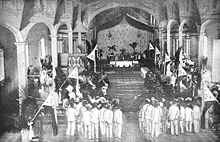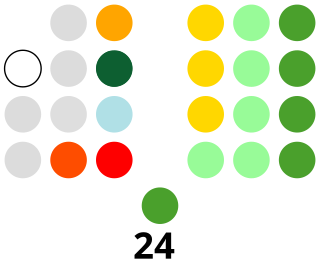
The Congress of the Philippines is the legislature of the national government of the Philippines. It is bicameral, composed of a lower body, the House of Representatives, although colloquially the term "Congress" commonly refers to just the latter, and an upper body, the Senate. The House of Representatives meets in the Batasang Pambansa in Quezon City while the Senate meets in the GSIS Building in Pasay.
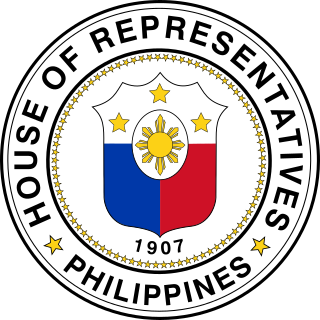
The House of Representatives of the Philippines is the lower house of Congress, the bicameral legislature of the Philippines, with the Senate of the Philippines as the upper house. The lower house is usually called Congress, although the term collectively refers to both houses.

The Senate of the Philippines is the upper house of Congress, the bicameral legislature of the Philippines with the House of Representatives as the lower house. The Senate is composed of 24 senators who are elected at-large under plurality-at-large voting.

The Batasang Pambansa, often referred to simply as the Batasan, was the legislature of the Philippines, established as an interim assembly in 1978 and later as an official body in 1984. It was the fourth unicameral legislature in Philippine history. Members of the Batasang Pambansa were referred to as "Mambabatas Pambansa", shortened to "MP".
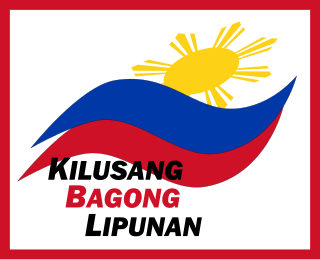
The New Society Movement, formerly named the New Society Movement of United Nationalists, Liberals, et cetera, is a right-wing political party in the Philippines. It was first formed in 1978 as an umbrella coalition of parties supporting then-President Ferdinand E. Marcos for the Interim Batasang Pambansa and was his political vehicle during his 20-year regime. It was reorganized as a political party in 1986, and is the furthest to the right of the political spectrum among active parties after Marcos' ouster.

The legislative districts of Quezon City are the representations of the highly urbanized city of Quezon in the various national and local legislatures of the Philippines. At present, the province is represented in the House of Representatives of the Philippines by its six congressional districts, with the districts' representatives being elected every three years. Additionally, each district is allotted six seats in the Quezon City Council, creating a total of thirty-six elective seats in the legislature.
The legislative districts of Aurora are the representations of the province of Aurora in the various national legislatures of the Philippines. The province is currently represented in the lower house of the Congress of the Philippines through its lone congressional district.
The legislative districts of Batangas are the representations of the province of Batangas in the various national and local legislatures of the Philippines. At present, the province is represented in the House of Representatives of the Philippines by its six congressional districts, with the districts' representatives being elected every three years. Additionally, each district is allotted two seats in the Batangas Provincial Board, creating a total of twelve elective seats in the legislature.
The legislative districts of Pampanga are the representations of the province of Pampanga and the highly urbanized city of Angeles in the various national legislatures of the Philippines. At present, the province and the city are represented in the House of Representatives of the Philippines by its four congressional districts.
The legislative districts of Nueva Ecija are the representations of the province of Nueva Ecija in the various national legislatures of the Philippines. The province is currently represented in the lower house of the Congress of the Philippines through its first, second, third, and fourth congressional districts.

The legislative districts of Bulacan are the representations of the province of Bulacan in the various national legislatures of the Philippines. The province is currently represented in the lower house of the Congress of the Philippines through its first, second, third, fourth, fifth and sixth congressional districts.

The legislative districts of Laguna are the representations of the province of Laguna in the various national legislatures of the Philippines. The province is currently represented in the lower house of the Congress of the Philippines through its first, second, third, and fourth congressional districts.
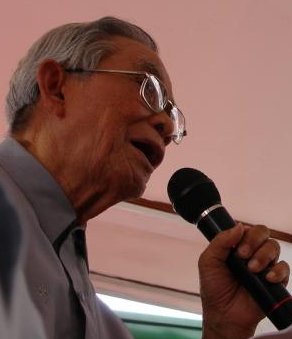
The 1987 election of members to the Senate of the Philippines was the 23rd election to the Senate of the Philippines. It was held on Monday, May 11, 1987. The Philippine Senate was re-instituted following the approval of a new constitution in 1987 restoring the bicameral Congress of the Philippines; earlier, a constitution was approved in 1973 that created a unicameral Batasang Pambansa (parliament) that replaced the bicameral Congress. The last Senate election prior to this was the 1971 election.

A senatorial election was held on November 8, 1971 in the Philippines. The opposition Liberal Party won five seats in the Philippine Senate while three seats were won by the Nacionalista Party, the administration party; this was seen as a consequence of the Plaza Miranda bombing on August 21, 1971, which wounded all of the Liberal Party's candidates and almost took the lives of John Henry Osmeña and Jovito Salonga. Their terms as senators were cut short as a result of the declaration of martial law by President Ferdinand Marcos on September 23, 1972.

The 2010 Philippine House of Representatives elections were held on May 10, 2010, to elect members to the House of Representatives of the Philippines to serve in the 15th Congress of the Philippines from June 30, 2010, to June 30, 2013. The Philippines uses parallel voting for seats in the House of Representatives; a voter has two votes: one for a representative from one's legislative district, and another for a sectoral representative via closed lists under the party-list system, with a 2% election threshold and 3-seat cap, when the parties with 2% of the national vote or more not meeting the 20% of the total seats, parties with less than 2% of the vote will get one seat each until the 20% requirement is met.

Elections were held in the Autonomous Region in Muslim Mindanao (ARMM) for seats in the House of Representatives of the Philippines on May 10, 2010.

The Batasang Pambansa Complex, or simply the Batasan, is the seat of the House of Representatives of the Philippines. It is located along the Batasan Road in Batasan Hills, Quezon City.
Elections for the House of Representatives of the Philippines were held on November 11, 1969. Held on the same day as the presidential election, the party of the incumbent president, Ferdinand Marcos's Nacionalista Party, won a majority of the seats in the House of Representatives.
The legislative district of Calamba are the representations of the component city of Calamba in the Congress of the Philippines. The city is currently represented in the lower house of the Congress through its lone congressional district.
